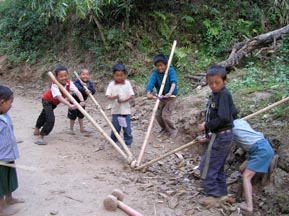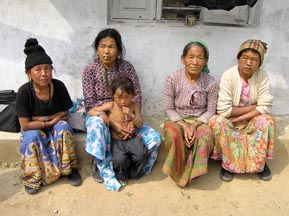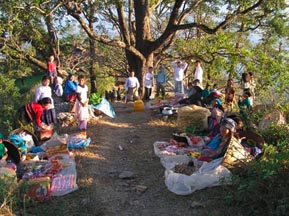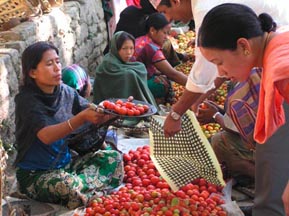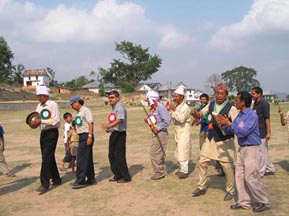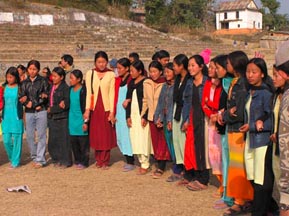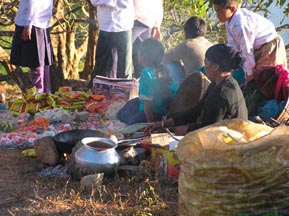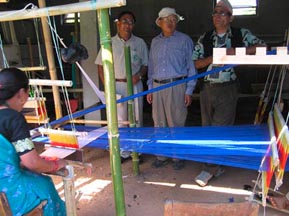MA theses
The acquisition of aspect in Chintang and Italian
Claudia Polkau, 2009
Within the framework of my master thesis supervised by Dr. Sabine Stoll and Prof. Dr. Balthasar Bickel I mainly focused on acquisition of the grammatical aspect in two typologically distinct languages. By means of aspect acquisition theories (Li & Shirai, Andersen & Shirai, Antinucci & Miller, etc.) and child language data taken from corpora of the CHILDES database as well as the CPDP child language longitudinal corpus I wanted to show that children, despite the complexity of their language(s) they acquire and the diversity of existing aspect systems within the languages, use similar acquisition strategies.
One prominent aspect acquisition hypothesis states that children first use telic verbs (inherent-lexical aspect) with past tense forms which in turn are grammatical means to express aspect(-mood) within languages. Children only start using static and dynamic verbs with present tense forms only after this.According to the hypothesis, thismust be seen as a gradual process: children acquire perfective aspect before imperfective aspect.
Data analyses revealed that infant speakers, both Italian and Chintang children, follow this acquisition pattern, because perfective (past tense) forms were found at earlier recording stages than imperfective forms (present tense).
With regard to a quantitative-qualitative analysis data did not reveal clear results because of one-time-only occurrences of different verbs which may be due to the over-all number of verb forms found which were subject to the objective of the study in question and variation among the speakers. But I observed a strong preference for core verbs belonging to both the telic and atelic class.
Identification of syntactic patterns in large corpora and aspects of structure in Chintang child-surrounding speech
Taras Zakharko, 2009
Recent studies in language acquisition suggest that children may learn the language with the help of the lexical frames - rigid morphosyntactic patterns with open slots (e.g. 'This is ...', 'Are you...', "What is...'). It has been shown that such frames occur naturally and frequently in the language input received by children, which would allow them to acquire the syntax by the means of distributional learning. The master thesis concerns the identification of such frames in the child-surrounding Chintang speech, using naturalistic corpus data. It is shown that, the types and the structures of the frequent frames found in Chintang are remarkably similar to that of the frequent frames which have been reported for English and other european languages, despite the great typological difference between these languages.
Acquisition of Spatial Deixis in Chintang
Sebastian Sauppe, 10/2009–5/2010
Project description: In this M.A. thesis, a longitudinal corpus study on the acquisition of spatial deixis in Chintang in 3 to 4-year old children was undertaken. It was found that children have already acquired the morphosyntactic properties of spatial deictics but use them in another way than adults. Children use demonstratives much more often in a referential manner whereas the adult speakers use them more often in an adverbial manner. The acquisition of the expression of topological relations was also investigated and it turned out that this kind of expressions is barely used in Chintang discourse. Additionally, a pilot study on the use of pointing gestures by Chintang children and adults was undertaken.
The Acquisition of Relative Clauses in Chintang
Kristina Labs (née Kuhn), 5/2010–9/2010
Relative clause acquisition, as probably the acquisition of any other complex structure, is a process from simple structures to semantically and structurally complex constructions. This master’s thesis shows the relativizing strategy used in Chintang. A corpus analysis leads to quantitative and qualitative findings that are outlined in a list of features characterizing children’s as well as adult’s relative clauses in spoken discourse. The examinations also allow a summary of the factors that may influence children’s development of the usage of relative clauses in Chintang.
Die natürlichsprachliche Umgebung, in der Kinder im Chintang aufwachsen
Nicole Kantak, 28/10/2010–28/5/2011
In dieser sinotibetischen Sprachgemeinschaft wachsen Kinder zumeist in polyadischen Situationen auf. Das heißt, sie sind von mehreren Sprecher verschiedener Altersklassen umgeben, sodass sie auch viele Formulierungen hören, die sich nicht direkt an sie richten (s. Stoll et al., in Druck). Demnach wird in dieser Arbeit auf Basis der Longitudinaldaten zweier Chintang-Kinder im Alter von zwei Jahren die kindgerichtete Sprache („target child-directed speech“) getrennt von der Umgebungssprache („child-surrounding speech“) hinsichtlich quantitativer und qualitativer Faktoren untersucht. Ziel ist es, diesbezüglich nicht nur eine mögliche Variation innerhalb des Chintang aufzuzeigen, sondern ebenso die Rolle des Inputs anhand verschiedener Kontexte (u.a. das Sprachverhalten Erwachsener vs. Kinder) explizit herauszustellen. Eine wichtige Frage in der Spracherwerbsforschung ist in diesem Zusammenhang, ob Kinder nur vom direkten Input ihre Muttersprache erlernen oder dazu ebenso die Sprache nutzen, die sie umgibt (vgl. Lieven, 1994; Stoll et al., in Druck). Folglich wurde auch der Output der Zielkinder quantitativ und qualitativ analysiert, um darzulegen, inwiefern sich Charakteristika des Inputs auch im Sprachverhalten der Kinder widerspiegeln.
